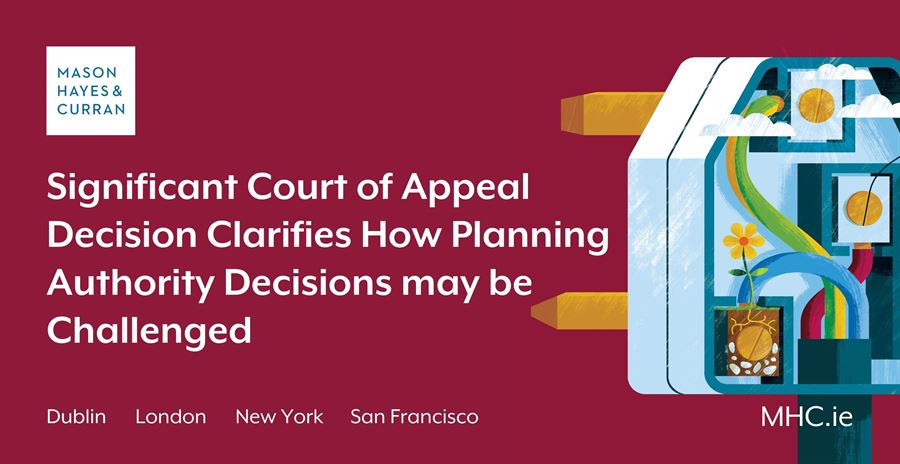
Planning permission for the erection of a wind farm was granted in 2005. A planning compliance submission was made by Barranafaddock Sustainable Electricity Limited (the Developer) to Waterford County Council in 2013 to agree the final turbine design.
Residents living near the windfarm in the townland of Ballyduff, County Waterford complained of noise and shadow flicker from the windfarm operated by the Developer. Investigations found that 9 of the 12 turbines had been built with larger turbine blades and lower hubs than was specified in the planning permission. In 2018, Waterford County Council made a section 5 referral to An Bord Pleanála (the Board). This was to determine if the changes to the turbines “as built” compared to those specified in the planning permission constituted “development” under the Planning and Development Act 2000, as amended (PDA).
On consideration of the section 5 referral, the Board made a declaration that the alterations to the turbines did not come within the scope of the planning permission. The board stated that they constituted “development” and not “exempted development” under the PDA.
High Court
The residents applied to the High Court to stop the operations of the windfarm under section 160 of the PDA. They argued that the turbines were an “unauthorised development”, and relied on the section 5 decision of the Board. The Developer argued that the changes in the turbines had been agreed with the local authority in 2013. The Developer also submitted that the deviation of the rotor diameter from 90m to 103m was “immaterial” in terms of the planning permission. Judge Simons rejected this. He held that as the wind farm was subject to the requirements of the Environmental Impact Assessment (the EIA) Directive, the proposed increase in rotor diameter was a “change” or “extension” to the project the subject of an EIA which could only have been lawfully authorised by an application for planning permission.
Court of Appeal
An appeal was brought to the Court of Appeal against the decision of the High Court. A number of arguments were raised, including:
-
Whether the section 5 decision of the Board could decide whether the “as built” turbines amounted to an “unauthorised development”,
-
Whether the applicants were prevented from arguing that the change in rotor diameter of the turbines was an “unauthorised development” in circumstances where the changes had been agreed by the planning authority on foot of the compliance submission submitted by the Developer in 2013, and
-
Depending on the above, whether the change in the rotor diameter of the “as built” turbines constituted a material or immaterial variation from what was permitted by the planning permission.
Firstly, the Court of Appeal held that under section 5 of the PDA, a declaration from the planning authority can only decide on what “development” and/or “exempted development” is. The Court added that the decision-making authority of the Board or the planning authority under section 5 does not extend to making declarations regarding “unauthorised development”. The Court of Appeal stated that where the development was carried out in accordance with an unchallenged and valid compliance decision, there was no basis to find that there had been “unauthorised development” in section 160 proceedings.
Secondly, the Court held that the PDA provides that points of detail may be agreed between the planning authority and a developer. It also held that once a decision had been made by the planning authority, or the Board on the conditions imposed in the permission for a development, this may only be challenged by way of judicial review.
The Court of Appeal rejected arguments that judicial review time limits do not apply where there has been an alleged breach of the EIA Directive. It held that there was nothing in the jurisprudence of the CJEU that prevented a member state from applying its own procedural autonomy in matters concerning the EIA Directive. This is provided the principles of equivalence and effectiveness were complied with.
Thirdly, the Court of Appeal held that where there has been compliance with a planning permission or any condition thereof, there can be no finding of “unauthorised development”. Any challenge to the permission or condition must be taken by way of judicial review. To prove an “unauthorised development”, the Court of Appeal stated that planning injunction proceedings under section 160 of the PDA would be necessary and the appropriate test applied. The only way to determine whether “unauthorised development” had taken place would be to remit the matter to the High Court for a fact finding exercise. However, as the case was decided on other grounds, this was deemed unnecessary.
Conclusion
The Court of Appeal has made it clear that challenges to planning authority decisions must be made by way of judicially reviewing that decision under section 50 of the PDA.
This recent judgment offers good news for developers, who will be able to securely rely on compliance submission decisions once they pass the normal judicial review time limits, except in the limited circumstances where the Court may extend this period.
For more information, please contact a member of our Planning and Environmental team.
The content of this article is provided for information purposes only and does not constitute legal or other advice.



